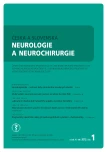Diagnostically Specific Findings in Posturography – Two Case Reports
Authors:
O. Čakrt1 ,2; T. Funda 2; R. Černý 3; P. Kolář 1; J. Mužík 2; J. Jeřábek 3
Authors‘ workplace:
Klinika rehabilitace a tělo-výchovného lékařství 2. LF UK a FN v Motole, Praha
1; České vysoké učení technické v Praze, Fakulta biomedicínského inženýrství, Společné pracoviště biomedicínského inženýrství FBMI a 1. LF UK v Praze
2; Neurologická klinika dospělých 2. LF UK a FN v Motole, Praha
3
Published in:
Cesk Slov Neurol N 2012; 75/108(1): 88-91
Category:
Case Report
Overview
Posturography is an electrophysiological method for evaluation of balance in unsteady patients. Posturography is very accurate but has very low specificity for nosologic diagnosis when basic routinely evaluated parameters, e.g. centre of pressure displacement etc., are used. However, power spectra analysis (Fast Fourier Transformation) of centre of pressure displacement during quiet stance can identify postural abnormalities patognomic for specific lesions of nervous system. We present two neurological disorders with specific posturographic patterns. Typical 3Hz sway in patients with anterior lobe cerebellar atrophy and increase sway in higher power spectra (12–18 Hz) in patients suffering from primary orthostatic tremor.
Key words:
posturography – frequency analysis – stance examination –
postural instability – cerebellar ataxia – primary orthostatic tremor
Sources
1. Furman JM, Baloh RW, Barin K, Hain TC, Herdman S, Horst RK. Assessment: posturography. Report of the Therapeutics and Technology Assessment Subcommittee of the American Academy of Neurology. Neurology 1993; 43(6): 1261–1264.
2. Shumway-Cook A, Horak FB. Assessing the influence of sensory interaction of balance. Suggestion from the field. Phys Ther 1986; 66(10): 1548–1550.
3. Valkovic P, Krafczyk S, Botzel K. Postural reactions to soleus muscle vibration in Parkinson’s disease: scaling deteriorates as disease progresses. Neurosci Lett 2006; 401(1–2): 92–96.
4. Rocchi L, Chiari L, Cappello A, Horak FB. Identification of distinct characteristics of postural sway in Parkinson’s disease: a feature selection procedure based on principal component analysis. Neurosci Lett 2006; 394(2): 140–145.
5. Diener HC, Dichgans J, Bacher M, Gompf B. Quantification of postural sway in normals and patients with cerebellar diseases. Electroencephalogr Clin Neurophysiol 1984; 57(2): 134–142.
6. Yarrow K, Brown P, Gresty MA, Bronstein AM. Force platform recordings in the diagnosis of primary orthostatic tremor. Gait Posture 2001; 13(1): 27–34.
7. Baloh RW, Jacobson KM, Beykirch K, Honrubia V. Static and dynamic posturography in patients with vestibular and cerebellar lesions. Arch Neurol 1998; 55(5): 649–654.
8. Fung VS, Sauner D, Day BL. A dissociation between subjective and objective unsteadiness in primary orthostatic tremor. Brain 2001; 124(2): 322–330.
9. Piboolnurak P, Yu QP, Pullman SL. Clinical and neurophysiologic spectrum of orthostatic tremor: case series of 26 subjects. Mov Disord 2005; 20(11): 1455–1461.
10. Hanssen A. Multidimensional multitaper spectral estimation. Signal Processing 1997; 58(3): 327–332.
11. Trouillas P, Takayanagi T, Hallett M, Currier RD, Subramony SH, Wessel K et al. International Cooperative Ataxia Rating Scale for pharmacological assessment of the cerebellar syndrome. The Ataxia Neuropharmacology Committee of the World Federation of Neurology. J Neurol Sci 1997; 145(2): 205–211.
12. Deuschl G, Bain P, Brin M. Consensus statement of the Movement Disorder Society on Tremor. Ad Hoc Scientific Committee. Mov Disord 1998; 13 (Suppl 3): 2–23.
13. Valkovic P, Krafczyk S, Benetin J, Saling M, Botzel K. Deterioration of postural stability in the progression of Parkinson’s disease: a posturographic study. Cesk Slov Neurol N 2004; 67/100(5): 347–353.
14. Krafczyk S, Tietze S, Swoboda W, Valkovic P, Brandt T. Artificial neural network: a new diagnostic posturographic tool for disorders of stance. Clin Neurophysiol 2006; 117(8): 1692–1698.
15. Krafczyk S, Schlamp V, Dieterich M, Haberhauer P, Brandt T. Increased body sway at 3.5–8 Hz in patients with phobic postural vertigo. Neurosci Lett 1999; 259(3): 149–152.
16. Visser JE, Carpenter MG, van der Kooij H, Bloem BR. The clinical utility of posturography. Clin Neurophysiol 2008; 119(11): 2424–2436.
Labels
Paediatric neurology Neurosurgery NeurologyArticle was published in
Czech and Slovak Neurology and Neurosurgery

2012 Issue 1
- Metamizole vs. Tramadol in Postoperative Analgesia
- Memantine in Dementia Therapy – Current Findings and Possible Future Applications
- Memantine Eases Daily Life for Patients and Caregivers
- Metamizole at a Glance and in Practice – Effective Non-Opioid Analgesic for All Ages
- Advances in the Treatment of Myasthenia Gravis on the Horizon
Most read in this issue
- Vertebroplasty – Treatment Option for Structurally Insufficient Vertebras
- Carpal Tunel Syndrome and Neurosurgeon – Experience after 2,200 Surgeries
- Guillain-Barré Syndrome in a Patient with a Renal Carcinoma – a Case Report
- Guidelines for Pharmacotherapy of Neuropathic Pain
